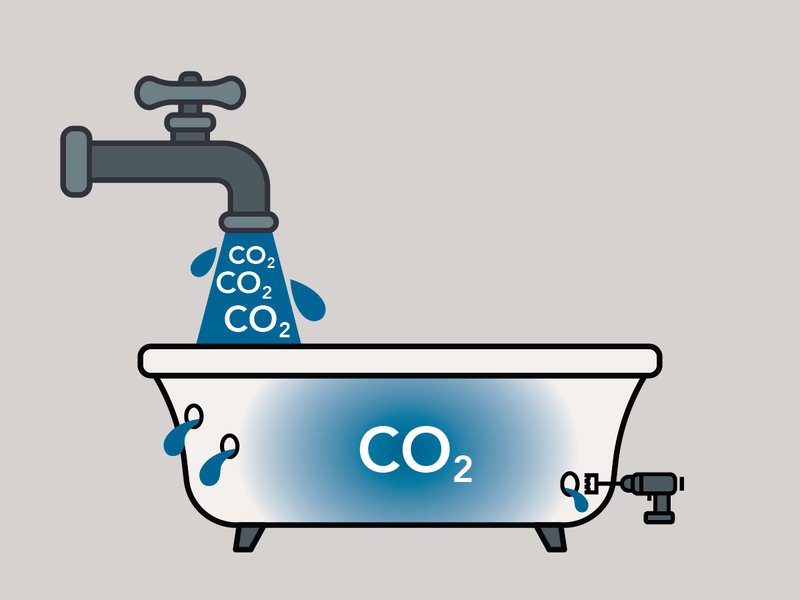Carbon Sequestration 101
Perspectives | Aug 14, 2025
One of the most powerful processes we know about, when it comes to slowing climate change, is the sequestration of carbon. Learn more about carbon sequestration in this 101 explainer.

As global temperatures rise and carbon dioxide (CO₂) concentrations continue to climb, scientists, policymakers, and communities are exploring every tool available to slow climate change. One of the most powerful processes we know about is the sequestration of carbon, which includes both natural and technology-driven processes that help stabilize our climate by reducing the amount of CO₂ in the atmosphere.
Carbon sequestration is a collection of processes in which carbon dioxide (CO₂) is captured and stored somewhere to prevent it from accumulating in the atmosphere and contributing to global warming. To better understand the role of carbon sequestration, imagine the atmosphere as a bathtub, and CO₂ as the water filling it:
- The faucet represents human activities that release CO₂, like burning fossil fuels. Today, that faucet is wide open.
- Closing the faucet — reducing emissions — is the most essential step to avoid filling up the tub.
But we also need to manage the water already in the tub. That’s where sequestration comes in:
- Natural carbon sinks, such as forests and the ocean, function like a drain that pulls water out of the tub.
- New technologies, such as marine carbon dioxide removal (mCDR), act like additional drainage holes, designed to remove CO₂ more deliberately or at larger scales.

This process occurs both naturally and through human interventions. Natural carbon sinks include forests, soils, and oceans. Scientists and other experts are also attempting to develop and scale carbon capture and storage (CCS) — a set of engineered techniques that capture CO₂ from industrial sources, like power plants and factories, and inject it deep underground into secure geological formations. Another growing area of interest is marine carbon dioxide removal (mCDR), which encompasses a range of ocean-based strategies designed to enhance natural carbon sinks or directly remove CO₂ from the atmosphere and store it in ocean systems. These approaches are still emerging and include ideas like seaweed cultivation, ocean alkalinity enhancement, and artificial upwelling. Additional research on the environmental consequences of these technologies is necessary before applying them.

Why carbon sequestration matters
CO₂ is the most prevalent greenhouse gas produced by human activities, particularly with the burning of fossil fuels. It traps heat in the atmosphere, contributing to the planet’s warming. The sequestration of carbon, both natural and engineered, helps counter this by pulling CO₂ out of the atmosphere and storing it in places where it can’t trap heat. It is one of the most critical strategies we have for slowing climate change. In fact, Earth’s natural carbon sinks — forests, soils, and especially the ocean — have already absorbed about half of all CO₂ humans have emitted since the Industrial Revolution. Without these sinks, atmospheric CO₂ levels would be nearly double what they are today, and global temperatures would be significantly higher.
Forms of carbon sequestration
Carbon sequestration occurs through different processes, and each play distinct roles in managing atmospheric CO₂ levels.
Terrestrial Sequestration: forests absorb CO₂ through photosynthesis and store it in trunks, branches, roots, and forest soils. Healthy soils, especially in grasslands and wetlands, can store large amounts of organic carbon.
Geological Sequestration: engineered systems can capture CO₂ from industrial processes and inject it deep underground into rock formations or depleted oil and gas reservoirs. This process is often associated with CCS technology.
Ocean Sequestration: the ocean is Earth’s largest carbon sink, absorbing about a quarter of the CO₂ humans emit each year.
While all of the above sequestration processes listed above are important, the ocean plays a particularly critical, and often invisible, role in regulating the planet’s climate.
The biological carbon pump is a planetary-scale climate regulator. It’s one of the most important, and least visible, processes helping to stabilize Earth’s atmosphere.
Jérôme Pinti Senior Scientist![This is the staff photo for Jerome Pinti]() Jérôme Pinti Senior Scientist
Jérôme Pinti Senior Scientist
How the ocean stores carbon
Oceanic carbon sequestration occurs through several processes, but two of the most important are known as the physical pump and the biological carbon pump.
The Physical Pump: cold, dense water near the poles absorbs CO₂ from the atmosphere and sinks to the deep ocean, carrying carbon with it. This process helps isolate carbon for centuries or longer.
The Biological Carbon Pump (BCP): Microscopic marine organisms called phytoplankton absorb CO₂ during photosynthesis at the ocean’s surface. When these organisms die, or when carbon moves through the food web as waste or organic matter, it can sink to deeper waters. Some marine animals also contribute by migrating vertically each day, transporting carbon to depth as they feed or excrete waste. They also transport carbon to the ocean depths where they die and sink to the bottom.

The biological carbon pump is one of the planet’s most powerful tools for natural carbon storage. Without it, atmospheric CO₂ concentrations would be about 50% higher than they were before the Industrial Revolution, making our planet significantly warmer. As GMRI researcher Dr. Jérôme Pinti, who studies the BCP, explains, "The biological carbon pump is a planetary-scale climate regulator. It’s one of the most important, and least visible, processes helping to stabilize Earth’s atmosphere." In Dr. Pinti’s recent paper on the BCP, he and his colleagues explain more about the mechanisms and implications of this crucial system, including the economic value of its continued ability to function.
Storing carbon in the ocean slows the rate of global warming, helping to keep Earth’s climate within livable limits, but it comes with trade-offs — particularly the challenge of acidification and potentially unforeseen ecological consequences. Ultimately, all types of carbon sequestration matter, and none are a substitute for cutting emissions at the source.
Carbon sequestration — especially in the ocean — is already playing a critical role in stabilizing our climate. But the ability of these natural systems to continue absorbing carbon depends on how well we protect and understand them. As research continues and new technologies emerge, we have an opportunity to support nature-based and engineered solutions that enhance the ocean’s climate-regulating capacity. At the same time, we must continue prioritizing efforts to reduce emissions at the source. By investing in ocean research, protecting marine ecosystems, and supporting innovation, we can help ensure the ocean remains a resilient and effective carbon sink for generations to come.



